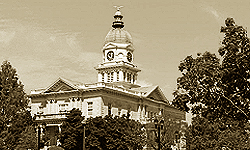EXPERIENCE. TRUST. RESULTS.
America’s Last Unsolved Mass Murder: July 25, 1946
On the evening of July 25, 1946, a mob of 20 to 30 white men ambushed four African Americans near the Moore’s Ford Bridge linking Walton and Oconee counties, about 50 miles east of Atlanta.
The victims were slaughtered in a barrage of gunfire, their bodies riddled with over 60 bullets then dumped near the banks of the Apalachee River. Their names were George W. Dorsey (a decorated World War II veteran), his wife Mae Murray, Roger Malcolm and his wife Dorothy.
Despite federal grand jury testimony in December 1946 and despite numerous FBI and GBI investigations spanning the next seven decades, no one was ever prosecuted for these murders.
In late 2013, Author/Historian Anthony S. Pitch retained attorney Joseph J. Bell (Bell, Shivas & Bell, P.C., Rockaway, NJ) to petition the courts for the release of the 1946 grand jury transcripts in order to shine the light of truth on a dark corner of American history.
In The News
- Petition to Supreme Court to Resolve Last Unsolved Lynching Case, 8/28/2020
- The Moore’s Ford Lynching: Presentation to the Hanover (NJ) Rotary Club, 8/20/2020
- The 1946 Moore’s Ford Lynching Case: The Path to the Supreme Court, 7/1/2020
- A 1946 lynching is still haunting us, by George F. Will, 6/5/2020
- Court: Grand Jury Records From Lynching Can’t Be Released, 3/30/2020
- Eleventh Circuit Court re-hears Pitch v. USA en banc, Tues., 10/22/2019, 9 AM
- Remembering Anthony S. Pitch, Tireless Crusader for Justice in Unsolved Lynching, dead at age 80 (6/29/2019)
- Secrets of 1946 Mass Lynching Could Be Revealed After Court Ruling (New York Times, 2/12/2019)
- Court: Release Georgia Lynching Case Transcripts (Atlanta Journal-Constitution, 2/11/2019)
- Appeals Court Orders Grand Jury Testimony Unsealed in 1946 Case (The Washington Post, 2/12/2019)
- Ruling May Help Unlock Answers to Notorious 1946 “Moore’s Ford” Lynchings (CBS News, 2/12/2019)
- Court orders secret transcripts released in 1946 case considered to be America’s last mass lynching (CNN, 2/12/2019)
- Court Upholds Order to Unseal Records in Brazen Lynching (US News & World Report, 2/11/2019)
- NJ Lawyer Prevails in Unsealing Grand Jury Transcript in 1946 Lynching Case (NJ Law Journal, 2/12/2019)
- With 2nd court victory, Morris lawyer Joe Bell brings justice closer for victims of mass lynching (MorristownGreen.com, 2/12/2019)
- Unsolved mass lynching grand jury testimony set for release thanks to N.J. lawyer (NJ.com, 2/11/2019)

In 1946, Eugene Talmadge runs a racially charged campaign for governor. On July 14, black farmhand Roger Malcolm stabs his boss.

2: THE LYNCHING: July 25, 1946


The crime generates national outrage. President Truman sends the FBI to Walton County, Georgia, amid nationwide protests.












Practice Areas
- Employment Law

